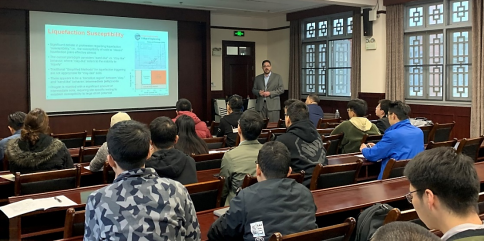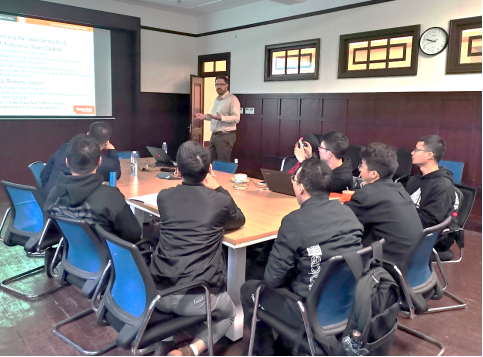Invited by Prof. Liu Hanlong and Prof. Xiao Yang, Prof. Armin W. Stuedlein from Oregon State University visited school of civil engineering, Chongqing University for academic exchange. On the morning of Nov. 15th Prof. Armin made a report titled “Use of Controlled Blasting for the Evaluation of the Deep, In Situ Dynamic Response of Soils” in No. 1 conference hall, and visited the laboratory of geotechnical engineering, structural engineering and vibrostand. Then in the afternoon he had a discussion with teachers and students in the café.

During the report, Prof. Armin explained how to evaluate in situ dynamics and response of soils with the use of controlled blasting. The wonderful report received a round of applause. Accompanied by Prof. Xiao, Prof. Yang Zhongping and Prof. Zhou Hang, Prof. Armin visited the laboratory of geotechnical engineering, structural engineering and vibrostand where more details about the laboratory of transparent soil, biological geotechnics, vibrostand and structural engineering was showed. Meanwhile, some students compared notes with Prof. Armin.
On the morning of Nov. 16th Prof. Armin made a report titled “Recovery of Small-Strain Stiffness following Blast-Induced Liquefaction” in No. 2 conference hall and exhibited more detailed information about recovery of small-strain stiffness after blast-induced liquefaction. After the presentation, students and teachers had a discussion about in situ experiments and data analysis with him. In the afternoon, Prof. Armin discussed academic problems with teachers and students of school of civil engineering, Chongqing University in the café.

Armin W. Stuedlein serves on the Soil Improvement and Risk Assessment and Management Committees at the ASCE Geo-Institute, and is an Associate Editor for the Journal of Geotechnical and Geoenvironmental Engineering. His research focuses on ground improvement, reinforced soils, foundations, and the characterization and incorporation of inherent soil variability and model transformation errors, with methodologies that range from full-scale testing, element-level laboratory work, and numerical and statistical simulations.
